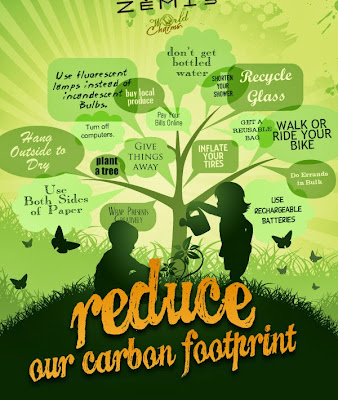What is carbon footprint?
Just as walking on sand leaves a footprint, almost all our
actions-from switching on the lights when you wake up in the morning to turn
them off at night-leaves an impact on the planet’s environments. Carbon
footprint is a way to measure this impact .To power our lights, run our vechicles,
generates electricity for our use, run factories, and by for almost everything
that we do, we require energy. This energy is produced by burning fossil
fuels.oil; gas and coal are fossil fuels. The burning of fossil fuels, besides
producing energy, results in the emissions of carbon dioxide and other
greenhouse gases like methane and nitrous dioxide.
Greenhouse gases can be emitted through
transport, land clearance, and the production and consumption of food, fuels,
manufactured goods, materials, wood, roads, buildings, and services. For simplicity of reporting, it is often expressed in terms of
the amount of carbon dioxide, or its equivalent of other GHGs, emitted.
"A measure of the total amount of carbon
dioxide (CO2) and methane (CH4) emissions of a defined
population, system or activity, considering all relevant sources, sinks and
storage within the spatial and temporal boundary of the population, system or
activity of interest. Calculated as carbon dioxide equivalent (CO2e)
using the relevant 100-year global warming
potential (GWP100)."Is known as carbon footprint. OR in a simpler
language it can also be defined as-
“The carbon footprint of a person, product or an activity
refers to the amount of greenhouse gases released into the atmosphere by a
particular person, product or activity, either directly or indirectly. The term
carbon footprint comes from the fact that the carbon dioxide is the most
prevalent greenhouse gas”.
The concept name of the carbon footprint originates from ecological footprint, discussion, which was developed by Rees and
Wackernagel in the 1990s which estimates the number of "earths" that
would theoretically be required if everyone on the planet consumed resources at
the same level as the person calculating their ecological footprint. However,
carbon footprints are much more specific than ecological footprints since they
measure direct emissions of gasses that cause climate change into the atmosphere.
Measuring
Carbon Footprints

An individual's, nations, or organization's carbon footprint can be measured by undertaking a GHG emissions assessment or other calculative activities denoted as carbon accounting. Once the size of a carbon footprint is known, a strategy can be devised to reduce it, e.g. by technological developments, better process and product management, changed Green Public or Private Procurement (GPP), carbon capture, consumption strategies, and others.
Several free online carbon footprint calculators exist with at least one supported by publicly available peer-reviewed data and calculations from the University of California, Berkeley's Cool Climate Network research consortium. These websites ask you to answer more or less detailed questions about your diet, transportation choices, home size, shopping and recreational activities, usage of electricity, heating, and heavy appliances such as dryers and refrigerators, and so on. The website then estimates your carbon footprint based on your answers to these questions.
The mitigation of carbon footprints through the development of alternative projects, such as solar or wind energy or reforestation, represents one way of reducing a carbon footprint and is often known as Carbon offsetting.

Every day the
choices we make about the food we eat, products we buy, what we wear and how we
travel creates greenhouse gases, directly or indirectly. Though living things
emit carbon dioxide when they breathe, carbon dioxide is widely considered to
be a pollutant when associated with car, planes, power plants and other human
activities that involve the burning of the fossil fuels. In the past 150 years,
increased uses of fossil fuels and other human activities (for example,
deforestation) have led to increase levels of carbon dioxide and other
greenhouse gases in our atmosphere.
Emission factors of common fuels
|
|||
Fuel/
Resource |
Thermal
g(CO2-eq)/MJth Grams of CO2equivalent per Mega joule of thermal energy |
Energy Intensity
W·hth/W·he |
Electric
g(CO2-eq)/kW·he Grams of CO2equivalent per Kilowatt-hour of electrical energy |
Coal
|
B:91.50–91.72
Br:94.33 88 |
B:2.62–2.85
Br:3.46 3.01 |
B:863–941
Br:1,175 955 |
Oil
|
73
|
3.40
|
893
|
Natural gas
|
cc:68.20
oc:68.4 |
_
|
cc:577
oc:751 599 |
Geothermal
Power |
3
|
TL0–1
TH91–122 |
|
Uranium
Nuclear power |
−
|
WL0.18
WH0.20 |
WL60
WH65 |
Hydroelectricity(run of river)
|
−
|
0.046
|
15
|
Conc. Solar
Power
|
_
|
40±15
|
|
Photovoltaics
|
_
|
0.33
|
106
|
Wind power
|
_
|
0.066
|
21
|
Note:-
3.6
MJ = mega joule(s) == 1 kW·h = kilowatt-hour(s), thus 1 g/MJ = 3.6 g/kW·h.
Legend: B = Black coal (supercritical)–(new subcritical), Br = Brown coal (new subcritical), cc = combined cycle, oc = open cycle, TL = low-temperature/closed-circuit (geothermal doublet), TH = high-temperature/open-circuit, WL = Light Water Reactors, WH = Heavy Water Reactors, #Educated estimate.
Legend: B = Black coal (supercritical)–(new subcritical), Br = Brown coal (new subcritical), cc = combined cycle, oc = open cycle, TL = low-temperature/closed-circuit (geothermal doublet), TH = high-temperature/open-circuit, WL = Light Water Reactors, WH = Heavy Water Reactors, #Educated estimate.
Why is
carbon footprint a matter of concern?
Higher carbon
footprint means higher levels of carbon dioxide and other greenhouse gases in
our atmosphere greenhouse gases let the sun’s light into the earth’s atmosphere,
but they trap the heat that reflects back up into the atmosphere. In this way,
they act like the glass walls of a greenhouse, causing a greenhouse effect that
is necessary to keep earth warm enough to sustain life.however, increasing
levels of co2 and other greenhouse gases in our atmosphere are
causing an increase greenhouse effect. This phenomenon has resulted in an
increase in the average temperature of our planet. Rising temperatures will
cause adverse effects such as rising sea levels, submergence of low-lying islands,
climate changes and extinction of plants and animals. Therefore, the need of
the hour is to cut down on our carbon footprint.
As equal inhabitants of earth each of us have
moral and social responsibilities to our planet. One of them is to preserve
its life-giving environment for the generations that will inhabit it in the
future. For that it is imperative that we adopt eco-friendly lifestyles to
reduce our carbon footprint.
|
Ways to reduce carbon footprint
The most
common way to reduce the carbon footprint of humans is to Reduce,
Reuse, And Recycle. In manufacturing this can be done by recycling the packing
materials, by selling the obsolete inventory of one industry to the industry
who is looking to buy unused items at lesser price to become competitive.
Nothing should be disposed off into the soil, all the ferrous materials which
are prone to degrade or oxidize with time should be sold as early as possible
at reduced price.
This can also
be done by using reusable items such as thermoses for daily coffee or plastic
containers for water and other cold beverages rather than disposable ones. If
that option isn't available, it is best to properly recycle the disposable
items after use. When one household recycles at least half of their household
waste, they can save 1.2 tons of carbon dioxide annual.
Another easy
option is to drive less. By walking or biking to the destination rather than
driving, not only is a person going to save money on gas, but they will be
burning less fuel and releasing fewer emissions into the atmosphere. However,
if walking is not an option, one can look into carpooling or mass
transportation options in their area.
Yet another
option for reducing the carbon footprint
of humans is to use less air conditioning and heating in the home. By adding
insulation to the walls and attic of one's home, and installing weather
stripping or caulking around doors and windows one can lower their heating
costs more than 25 percent. Similarly, one can very inexpensively upgrade the
“insulation” (clothing) worn by residents of the home. For
example, it's estimated that wearing a base layer of long underwear (top and
bottom) made from a lightweight, super insulating fabric like micro fleece (akaPolartec®,
Capilene®) can conserve as much body heat as a full set of clothing, allowing a
person to remain warm with the thermostat lowered by over 5° C. These
measures all help because they reduce the amount of energy needed to heat and
cool the house. One can also turn down the heat while sleeping at night or away
during the day, and keep temperatures moderate at all times. Setting the
thermostat just 2 degrees lower in winter and higher in summer could save about
1 ton of carbon
dioxide each
year.
Choice of
diet is a major influence on a person's carbon footprint. Animal sources of
protein (especially red meat), rice (typically produced in high
methane-emitting paddies), foods transported long distance and/or via
fuel-inefficient transport (e.g., highly perishable produce flown long
distance) and heavily processed and packaged foods are among the major contributors
to a high carbon diet. Scientists at the University of Chicago have estimated "that
the average American diet – which derives 28% of its calories from animal foods
– is responsible for approximately one and a half more tonnes of greenhouse gasses
– as CO2 equivalents – per person, per year than a fully plant-based, or vegan,
diet."Their calculations suggest that even replacing one third of the
animal protein in the average American's diet with plant protein (e.g., beans,
grains) can reduce the diet's carbon footprint by half a tonne. Exchanging two
thirds of the animal protein with plant protein is roughly equivalent to
switching from a Toyota Camry to a Prius. Finally, throwing food out not only
adds its associated carbon emissions to a person or household's footprint, it
adds the emissions of transporting the wasted food to the garbage dump and the
emissions of food decomposition, mostly in the form of the highly potent
greenhouse gas, methane.
The carbon
handprint movement emphasizes individual forms of carbon offsetting, like using
more public transportation or planting trees in deforested regions, to reduce
one's carbon footprint and increase their "handprint."
Furthermore,
the carbon footprint
in the food industry
can be reduced by optimizing the supply chain. A life cycle or supply
chain carbon footprint
study can provide useful data which will help the business to identify critical
areas for improvement and provides a focus. Such studies also demonstrate a
company’s commitment to reducing carbon footprint now ahead of other
competitors as well as preparing companies for potential regulation. In
addition to increased market advantage and differentiation eco-efficiency can
also help to reduce costs where alternative energy systems
are implemented.
Small steps to reduce carbon footprints..................................Big leaps towards a greener future,
1 –when you choose to
take a walk in a park for a couple of hours everyday instead of watching
tv/computer,you benefit the planet’s health.by making this choice you prevent
The emission of 62-94
kg of co2 annually !!!
2- using an LED table
lamp instead of an incandescent light bulb while studying provides more effective lighting.it also benefits our environment by reducing co2 emission by 55 kg annually !!











